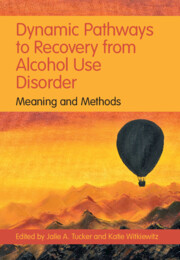Book contents
- Dynamic Pathways to Recovery from Alcohol Use Disorder
- Dynamic Pathways to Recovery from Alcohol Use Disorder
- Copyright page
- Dedication
- Contents
- Figures
- Tables
- Contributors
- Foreword
- Preface
- Acknowledgments
- Introduction
- Part I Micro Level
- 2 Biopsychosocial Process of Change in Alcohol Use Disorder Recovery
- 3 The Role of Self-Regulation Strategies in Recovery from Alcohol Use Disorder
- 4 Neuropsychological and Biological Influences on Drinking Behavior Change
- 5 Lifespan Developmental Perspectives on Natural Mechanisms of Cessation of Risky Alcohol Use and Recovery from Alcohol Use Disorder
- 6 Mutual Help Approaches and Mechanisms of Change
- 7 Time-Varying Effect Modeling to Examine Recovery Outcomes across Four Years
- 8 Latent Variable Mixture Modeling Approaches to Investigating Longitudinal Recovery Processes
- Part II Meso Level
- Part III Macro Level
- Conclusions and Future Directions
- Index
- References
6 - Mutual Help Approaches and Mechanisms of Change
from Part I - Micro Level
Published online by Cambridge University Press: 23 December 2021
- Dynamic Pathways to Recovery from Alcohol Use Disorder
- Dynamic Pathways to Recovery from Alcohol Use Disorder
- Copyright page
- Dedication
- Contents
- Figures
- Tables
- Contributors
- Foreword
- Preface
- Acknowledgments
- Introduction
- Part I Micro Level
- 2 Biopsychosocial Process of Change in Alcohol Use Disorder Recovery
- 3 The Role of Self-Regulation Strategies in Recovery from Alcohol Use Disorder
- 4 Neuropsychological and Biological Influences on Drinking Behavior Change
- 5 Lifespan Developmental Perspectives on Natural Mechanisms of Cessation of Risky Alcohol Use and Recovery from Alcohol Use Disorder
- 6 Mutual Help Approaches and Mechanisms of Change
- 7 Time-Varying Effect Modeling to Examine Recovery Outcomes across Four Years
- 8 Latent Variable Mixture Modeling Approaches to Investigating Longitudinal Recovery Processes
- Part II Meso Level
- Part III Macro Level
- Conclusions and Future Directions
- Index
- References
Summary
Mutual help programs are popular resources for persons with alcohol use disorder (AUD) and clinical referral to such programs is common. This chapter describes what is currently known about four established mutual help programs in the United States: Alcoholics Anonymous (AA), SMART Recovery, Women for Sobriety (WFS), and LifeRing. Strong correlational research indicates that AA is associated with increased abstinence and that this association arises in part because of increased social support, abstinence self-efficacy, and spiritual practices. There is little support that reductions in anger, selfishness, and depression account for AA-related benefit. Preliminary evidence indicates that persons reporting lower religiosity and higher education are more likely to affiliate with non-AA mutual help programs and that these programs may be efficacious. A series of recommendations are made to advance our knowledge of these mutual help programs, with an emphasis on the need for future investigations of SMART, WFS, and LifeRing.
Keywords
- Type
- Chapter
- Information
- Dynamic Pathways to Recovery from Alcohol Use DisorderMeaning and Methods, pp. 95 - 113Publisher: Cambridge University PressPrint publication year: 2022



